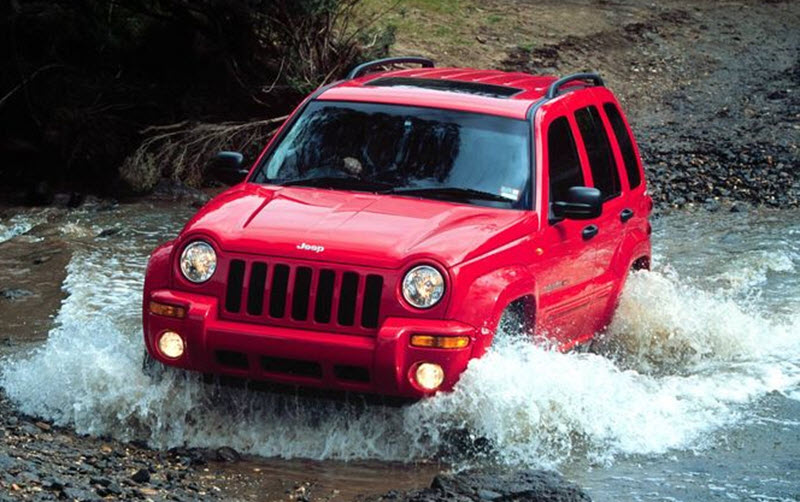Jeep Cherokee (KJ)
The Jeep Cherokee (KJ) was a compact SUV produced and marketed by Jeep for the model years 2002-2007. On the North American market, it was known as the Jeep Liberty (KJ).
The KJ, which replaced the Jeep Cherokee XJ, was priced above the Wrangler and below the Grand Cherokee. Designed by a team led by Bob Boniface in 1998, the KJ featured a unibody-construction. Until the 4-door Compass and Patroit were launched by Jeep in time for 2007, the KJ was the smallest of Jeep’s 4-door SUVs. The styling for the KJ was inspired by both the Dakar and the Jeepster concept vehicles.
In more than one way, the KJ broke with the Jeep tradition:
- The KJ was the first Jeep vehicle with rack and pinion steering.
- The KJ was the first Jeep with PowerTech engines. (The 150 hp 2.4 L straight-4, which was discontinued in 2006, and the 210 hp 3.7 L V6.)
- The KJ wasn’t the first Jeep with independent front suspension, because this honor goes to the 1963 model Jeep Wagoneer. It is worth noting however that for the Jeep Wagoneer, independent front suspension was just a short-lived option and only available for 4WD versions.

Short facts about the KJ
| Manufacturer | DaimlerChrysler (2002-2007) Chrysler LLC (2007) |
|
Also called |
Jeep Liberty (KJ) |
|---|---|
|
Production |
2001–2006 |
|
Model years |
2002–2007 |
|
Wheelbase |
104.2 in (2,650 mm) |
|
Length |
2001-04: 174.2 in (4,420 mm) 2005-07: 174.7 in (4,440 mm) |
|
Width |
2001-04: 71.1 in (1,810 mm) 2005-07: 71.8 in (1,820 mm) |
|
Height |
2001-04: 73.2 in (1,860 mm) 2005-07: 69.8 in (1,770 mm) |
|
Curb weight |
3,508-4,312 lb (1,591-1,956 kg) |
| Engine |
|
| Transmission |
|
Trims etc
Initially, the KJ was offered with three different trims for both 2WD and 4WD:
- Sport
The base trim for the 2002-2007 model years
- Renegade
A rugged style trim with a focus on off-roading.
Available between midyear 2002 and 2007.
Included, among other things, a 3.7L Power-Tech V6 engine, cloth-and-vinyl trimmed seating surfaces, air conditioning, power windows, door locks with keyless entry, and 16 inch color-keyed aluminium-alloy wheels in Light Khaki, Mineral Grey or Cactus Green, grey front and rear decorative wheel flares, Anti-Lock Braking System, AM/FM stereo with CD player, and front-mounted fog lamps.
- Limited
The top-end trim for the 2002-2007 model years.
Examples of distinguishing features were the security system, the chrome body side cladding panels, the color-keyed front and rear bumpers, the overhead Electronic Vehicle Information Center (EVIC), anbd the low-back front bucket seats with premium cloth seating surfaces.
Many luxury details for available for an additional cost, such as a stereo with Radio Data System (RDS), Infinity premium amplified audio system, dual heated front bucket seats, lucury leather-trimmed seating surfaces, power-adjustable front passenger’s bucket seat, and a power tilt-and-sliding sunroof. Eventually, a six-disc, in-dash CD changer was offered too.
Special editions
Examples of special edition Jeep Libertys (KJ):
- 2003 Freedom Edition
- 2004 Columbia Edition
- 2005 Rocky Mountain Edition
- 2006 65th Anniversary Edition
- 2007 Rocky Mountain Edition
Police use in the U.S.
Jeep never offered any special police package for the Jeep Liberty, but the SUV still became a popular choice for police use in the U.S. Most of the Jeep Liberty SUVs purchased for police use had the 210 hp 3.7L Power-Tech V6 engine and 4-speed automatic transmission. Many also used either the Selec-Trac or the Selec-Trac II4WD system.
European van (commerical vehicle)
For the European market, a Jeep Cherokee KJ van was released. Since it fullfilled the requirements of a Commerical Vehicle, it was beneficial from a tax point of view for VAT registered buyers. This van had a completely flat cargo area with a glavanized metal floor covered in carpet. Instead of rear quarter glass and rear door windows, the van sported fixed body colored aluminium panels. The van was powered by a 2.5 CRD engine with five-speed transmission. Fuel rating: 34.4 miles per imperial gallon (8.2 L/100 km).